I play a rock music trivia game with other music-nut friends in the Bay Area. It’s not one of those board games with question cards, though it started out that way. Instead, we make up our own questions, ranging from 1 (easiest) to 6 (hardest) depending on how we throw dice. Maybe I’ll post some used questions from time to time on this blog, though some of them lose something in the translation when you can’t declaim them in a grand tone of voice.
So to start, here are a couple of visual clues that might be harder than you think. Question #1: who’s the guy on the left in this picture?
Some of the incorrect guesses included Peter Noone (Herman of Herman & the Hermits), Elton John, Thomas Dolby, and Peter Asher (of Peter Asher). But it’s none of them. It’s Brian Jones of the Rolling Stones. The girl is his younger sister, Barbara.
Prior to this (admittedly blurry) showing up recently, I’d never seen a photo of him dating from before 1962, with the exception of one baby picture. What really throws contestants (only one player got the correct answer) is that Jones doesn’t wear glasses in any of the pictures I’ve seen of him as an adult.
Many Stones fans don’t know, by the way, that Jones had two younger sisters, not just one. The older of those two sisters (born shortly after Brian), Pamela, died of leukemia just after her second birthday.
Here’s another visual clue. Who’s the guy on right, holding a banjo? He too would become very famous (and he’s not Brian Jones).
That’s Roger (then Jim) McGuinn, about three years before he’d co-found the Byrds with Gene Clark and David Crosby. Back in 1961, he was just a sideman to the whitebread folk revival group the Chad Mitchell Trio. By 1965 he’d be sounding and looking a lot different (and much for the better) as lead guitarist, and frequent lead singer, of the Byrds. That’s McGuinn with shades on the right:
McGuinn appears on another Chad Mitchell LP, this one from 1962. That’s him in the back on the left, if you can make him out. Seems like they were trying to hide him:
After McGuinn became a star with the Byrds, the Chad Mitchell Trio – now billing themselves as the Mitchell Trio, with another pre-star, John Denver, in their lineup – recorded a sort of protest against protest folk-rock, “The Sound of Protest (Has Begun to Pay),” with an obviously Byrds-like arrangement. Far from being a jibe at his having sold out, one feels the Chad Mitchell Trio might have been jealous of both his commercial success and his groundbreaking innovations as a vanguard folk-rocker. The Byrds are still revered as one of the greatest bands of all time. The Chad Mitchell Trio (or Mitchell Trio, as they were known after the departure of their leader), one of the tamer of the many wholesome folk groups to emerge in the wake of the Kingston Trio, are on the verge of being forgotten.
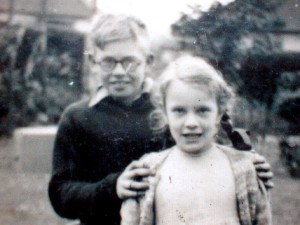
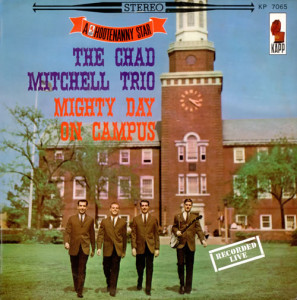
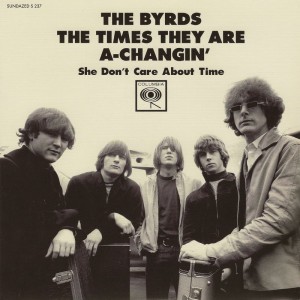
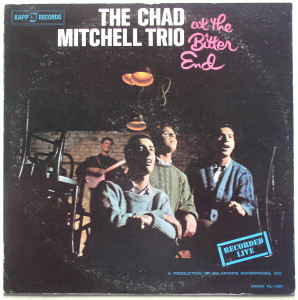
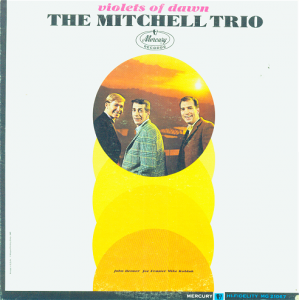
I’ve been a fan of your writing for quite some time now and have used you as an allusion and a source in some of my own, and I think that only you, Bruce Eder, and a handful of other music historians and critics give proper weight to both the popularity and quality (and at times, lack of the same) of the pop-folk groups of the late 1950s through the mid-1960s.
However, I think you’re just a bit off here about the Mitchell Trio, its ongoing relationship with McGuinn, and its intent in “The Sound Of Protest.” The song was co-written by Fred Hellerman of The Weavers, whose credentials as a member of that group as a singer and writer of topical songs are at the least pretty legitimate and whose lack of respect for commercial protesters is understandable. Further, the topic came up on Mudcat.org a few years back, and allow me to quote a couple of relevant posts – the first from a certain “JJ” who noted:
“I always thought the song AS WRITTEN was directed at Paul Simon — ‘sound of protest’ v. ‘sounds of silence.’ But there is no doubt that the song AS ARRANGED by Milt Okun takes an additional swipe at Jim (Roger) McGuinn, the Trio’s former guitarist.”
But the most important reply came from Joe Frazier of the CMT (who BTW died a month ago and whose funeral I attended this past weekend). Joe remarked:
“The song was inspired by the success of “Sound[sic} of Destruction” by Barry Maguire[sic]. When we did the arrangement, the Byrds were the musical inspiration – primarily because their sound was so fantastic. Take it as an homage to Jim McGuinn from a friend. The phenomenal thing about this recording was the fact that I was singing that incredibly high harmony instead of the melody (above JD!) Don’t know what in the world I was on, but I know I could never do it again! Thanks for all the compliments – I’ve always felt this was never ‘gotten’ by anyone.” – Joe Frazier
The discussion was from 2008 and can be accessed HERE.
As others note in that topic thread, The Byrds were never thought of primarily as a “protest” group as much as the great innovators of folk rock, playing as McGuinn has often noted (and likely as you yourself may have quoted him) “folk music with a Beatles beat” and presenting thoughtful songs by Dylan, Seeger, and others with lyrics considerably more reflective than the standard rock songs of the time. But Phil Ochs they weren’t, and I don’t think that either Hellerman or the CMT had The Byrds in their sights as targets for this (pretty weak) satirical song.
I’d add that you are spot-on about the CMT being on the verge of forgotten – but given the superb quality of the best of their work (’62 to ’65 I’d say), that’s a shame.
Thanks for your comment, Jim, especially the quote from Joe Frazier, which clarifies the intention of the arrangement of “The Sound of Protest.”